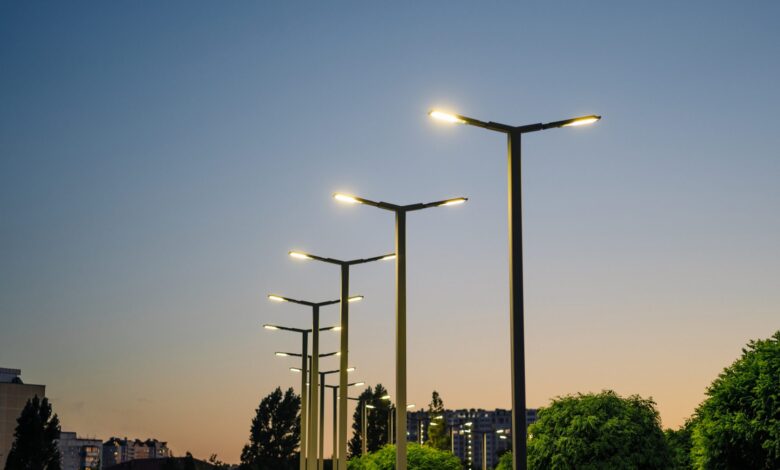Solar Street Lights: A Sustainable Lighting Revolution for Modern Cities

Solar street lights are outdoor lighting units powered by the sun. They work simply: during the day, solar panels on the lights absorb sunlight. This sunlight is converted into electrical energy, stored in batteries. When it gets dark, this stored energy powers LED lights, illuminating streets and pathways.
These lights are self-sustaining, drawing power from a natural source – the sun. They don’t need electricity from the grid, making them both eco-friendly and cost-effective. Solar street lights are a smart choice for lighting up outdoor areas, providing bright light without the need for traditional power sources.
In both urban and rural areas, solar street lights are pivotal. They offer a sustainable, cost-effective lighting solution. In cities, they reduce electricity costs and lower carbon emissions. In rural areas, where electricity may be scarce, they provide essential lighting, enhancing safety and accessibility. Their easy installation and low maintenance make them ideal for lighting up streets, parks, and public spaces, contributing significantly to community well-being and environmental health.
Components of Solar Street Lights
Solar street lights consist of four main parts: solar panels, LED lights, batteries, and controllers. Each plays a vital role in their function.
- Solar Panels: These are the heart of solar street lights. They capture sunlight and convert it into electricity. Mounted on top, they are usually angled to get maximum sun exposure.
- LED Lights: These are the visible part of the system. LED lights provide bright, clear illumination. They are energy-efficient, turning the stored solar power into light during the night.
- Batteries: Batteries store the electricity generated by the solar panels. They ensure the lights can still function, even after the sun goes down or on cloudy days.
- Controllers: Controllers are the brains of the system. They manage the power flow from the solar panels to the battery and then to the lights. They ensure the lights turn on when it gets dark and turn off when the sun rises.
How Solar Street Lights Work: Converting Sunlight to Electricity
Solar Street lights work by turning sunlight into electricity. Here’s how they do it in simple steps:
- Absorbing Sunlight: During the day, the solar panels on the lights soak up sunlight. These panels are made of cells that capture solar energy.
- Converting Energy: Inside these solar cells, the sunlight gets converted into electrical energy. This process happens through a natural reaction within the cells when they’re exposed to sunlight.
- Storing Energy: The electricity generated doesn’t get used straight away. Instead, it’s stored in batteries attached to the lights. These batteries act like power banks, holding the energy until it’s needed.
- Lighting Up: When it gets dark, the stored energy comes into play. The lights have sensors that detect when it’s night. They automatically switch on the LED lights using the electricity stored in the batteries.
- Repeating the Cycle: As the sun rises, the lights turn off. The solar panels start absorbing sunlight again, recharging the batteries for the next night.
Benefits of Solar Street Lights
Solar street lights are more than just a source of illumination; they’re a smart, sustainable choice with numerous benefits.
Environmental Impact
- Renewable Energy Source: These lights harness the sun’s power, a clean and endless energy source. This shift to solar reduces our reliance on fossil fuels, a crucial step towards a greener planet.
- Reducing Carbon Footprint: Solar street lights have a minimal environmental impact. They don’t emit greenhouse gases, helping to cut down the carbon footprint of our communities.
Cost-Effectiveness
- Saves on Electricity Bills: One of the biggest perks of solar street lights is their ability to lower electricity costs. Since they generate their own power, they offer significant long-term savings.
- Low Maintenance Needs: These lights are known for their durability. With fewer moving parts and long-lasting LED bulbs, they require less maintenance, saving money and effort over time.
Safety and Reliability
- Reliable in Various Weather Conditions: Designed to withstand different weather, solar street lights are a dependable source of light. Even on cloudy days, they can light up, thanks to stored solar energy.
- Enhances Public Safety: Well-lit streets are safer streets. These lights improve visibility at night, reducing the risk of accidents and making public spaces more secure.
Technological Advancements in Solar Street Lights
Solar street lights are evolving rapidly, thanks to technological advancements. These improvements are making them smarter, more efficient, and ready for future challenges.
Smart Features
- Motion Sensors: Modern solar street lights come equipped with motion sensors. These sensors detect movement, allowing the lights to brighten when someone passes by. This feature not only enhances safety but also conserves energy.
- Adaptive Lighting: Adaptive lighting technology adjusts the brightness based on the time of night and the amount of stored solar energy. This smart adaptation ensures optimal use of power.
- Remote Control: Remote control capabilities allow for easy management of light settings from a distance. This feature adds convenience in adjusting light schedules and modes.
Innovations in Efficiency
- Battery Advancements: Recent developments in battery technology have led to more efficient storage of solar energy. These advancements mean the lights can operate longer, even with less sunlight.
- Solar Panel Efficiency: Solar panels are becoming more efficient at converting sunlight into electricity. This increase in efficiency means even smaller panels can power the lights effectively, broadening their application.
Future Trends and Potential Developments
- Integration with Smart Cities: As cities become smarter, solar street lights are expected to integrate with other smart city technologies. This integration could lead to more efficient energy use and better urban management.
- AI and Machine Learning: Future solar street lights might use AI and machine learning to optimize energy use and maintenance schedules, making them even more efficient and cost-effective.
Conclusion
Solar street lights offer a blend of environmental benefits, cost-effectiveness, and technological advancement. They represent a significant step towards sustainable urban and rural development. The future of solar street lighting looks bright, with ongoing innovations promising even greater efficiency and integration. Adopting and investing in solar street lights is not just a smart choice for today, but a forward-thinking move for a greener, more sustainable tomorrow. Let’s embrace this eco-friendly lighting solution for a brighter future.



